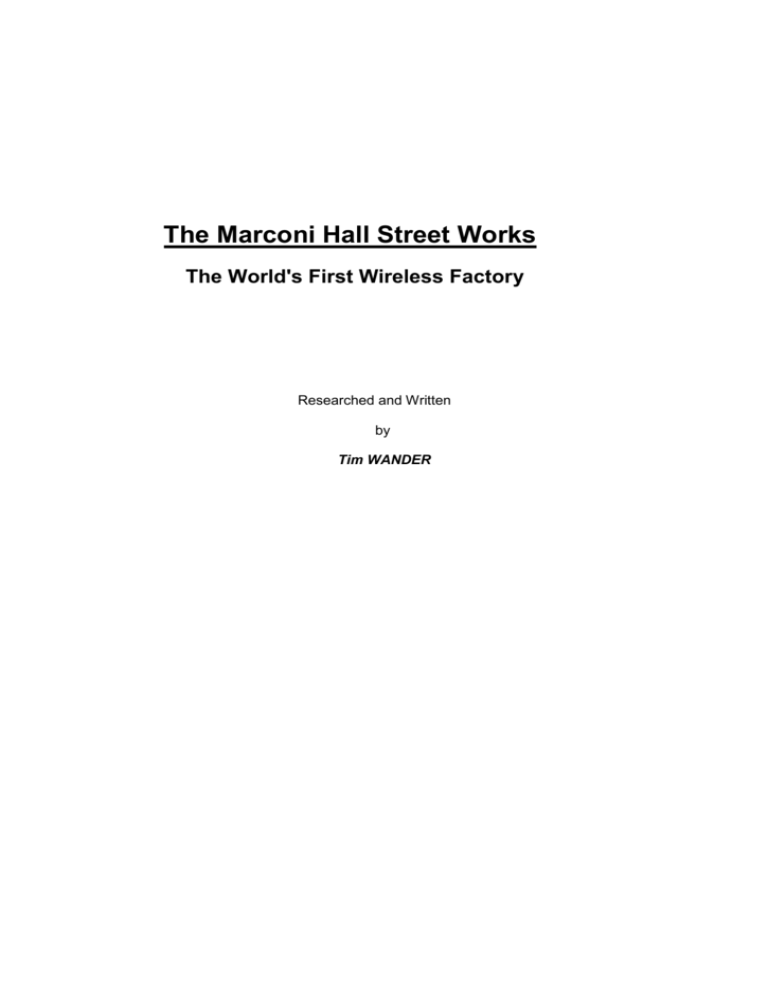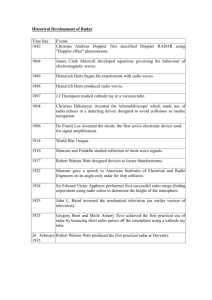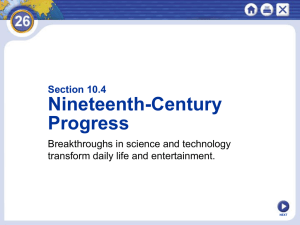Tim Wander - Marconi Heritage Group
advertisement

The Marconi Hall Street Works The World's First Wireless Factory Researched and Written by Tim WANDER ‘Radio shall contribute to the progress and common good of people in time of peace. It shall contribute to the triumph of justice and mankind in time of war.’ Guglielmo Marconi, just before his death in 1937, said to his good friend Luigi Solari ‘What other men have been content to prove impossible, he accomplished, and this is surely greatness. The history of wireless communication has been a history of miracles.’ The Times newspaper editorial, on the death of Marconi in 1937 Photos 1. The Marconi Hall Street Works in Chelmsford (MWT) 2. Marconi’s Hall Street Works, top floor research labs (MWT) 3. Marconi’s Hall Street Works, ground floor machine shop (MWT) 4. Marconi’s Hall Street Works, ground floor machine shop (MWT) 5. Marconi’s Hall Street Works, ground floor machine shop (MWT) 6. Marconi’s Hall Street Works, ground floor machine shop (MWT) 7. Marconi’s Hall Street Works, Marconi and the Hall Street engineers 8. Marconi’s Hall Street Works, the coil drying room (MWT) 9. Marconi’s Hall Street Works, the coil mounting room (MWT) 10. Marconi’s Hall Street Works, the coil mounting room (MWT) 11. Marconi’s Hall Street Works, the ladies of the winding shop (MWT) 12. Marconi’s Hall Street Works, the ladies of the winding shop (MWT) 13. Marconi’s Hall Street Works, the winding shop (MWT) 14. Advert for Marconi Ignition Coils, c. 1905 15. Hall Street Works, 2013 16. Hall Street Works plaque, 2013 17. (MWT) Hall Street Works interior, 2013 Acknowledgements Parts of this text have been extracted from : ‘2MT Writtle - The Birth of British Broadcasting’ by Tim Wander, Authors Online. ISBN 978-0-7552-0607- 0 © T.R. Wander 2010 and ‘Marconi’s New Street Works 1912-2012. Birthplace of the Wireless Age.' by Tim Wander, Authors Online. ISBN 978-0-7552-0693-3 © T.R. Wander 2013 Photographs marked (MWT) are reproduced by kind permission of GEC-Marconi. The others are © T.R. Wander. Marconi's Hall Street Works The World's First Wireless Factory. By the end of 1898 Guglielmo Marconi has spent years three hectic years testing and demonstrating his system for wireless communication across the world. He had run countless experiments and trials for the Royal Navy, British Army, United States Navy (and Army), Trinity House, GPO, Parliament, the British Royal family, scientists and newspapers. He had proved his case. His wireless telegraphy system was no longer a laboratory experiment. Marconi had developed a practical communication system that did not need wires. To meet the anticipated demand for new equipment the Marconi Company had been forced to urgently seek new premises for manufacturing and administration. The Company’s existing Head Office at 28 Mark Lane in the City of London were already overcrowded and could never support the proposed expansion or any form of large scale manufacturing. The world’s first wireless station built by Marconi at Alum Bay on the Isle of Wight was still based in the rented ground floor rooms of the Royal Needles Hotel. His new Haven Hotel wireless station near Poole on the South coast of England was also based in leased rooms. At the start of 1899 the Haven station had only been in operation for two months and its limited space was earmarked solely for research and development. Marconi made the decision to move very rapidly, his choice being a large building in the town of Chelmsford in Essex. The exact reason why Marconi chose Chelmsford is unclear. From his earliest research work in London Marconi had found that his experiments were often plagued with electrical noise from tramways and lifts and Chelmsford was still reasonably free from such problems. Chelmsford had other advantages as buildings were far cheaper outside London and the county of Essex is very flat, ideal for wireless experiments and erecting aerials. Chelmsford also had a direct rail link into the capital and was reasonably near the Port of London whose huge volume of shipping represented one of the Marconi Company’s immediate potential market places. Also Marconi did not particularly like London. Other than the social life and academic institutions the combination of smoke, smog and fog from millions of coal fires, along with the unpleasant odour of the streets, horses and unwashed bodies meant that Marconi preferred the open spaces of Essex. In the end the choice was probably influenced by a combination of all these factors, or perhaps it was just that suitable premises in Hall Street became available at the right time. It is also possible in 1896 when he first arrived in England that Marconi had travelled to Chelmsford to seek advice from Colonel Crompton whose electrical engineering company had been founded in Chelmsford in 1878. He may even have met another Chelmsford based electrical engineering company, Christy Brothers. Crompton's Electrical Engineering Works were amongst the best in the country and the Colonel and James Christy were good friends in the Chelmsford Industrial community. It also meant that Chelmsford had a large skilled workforce already familiar with electrical systems manufacture and an established power supply network. Marconi's choice for his first wireless equipment manufacturing premises was a large building located in Hall Street. When it was built by John Hall in 1858 it was a state of the art steam driven silk mill. John Hall had worked the mill until 1861 when the Government repealed the silk duties and French imports soon ruined the Essex silk industry. The Hall Street mill closed in 1863, but Samuel Courtaulds of Braintree, who survived the disaster, ran the mill from 1865 until 1892. It then became Messrs. Wenleys’ furniture storage depot. The site was ideal for Marconi’s requirements especially as the engine house still existed as did the line shafts to power equipment inside the works. The site also had a house attached now called Alfred Cottage (possibly named after Marconi’s brother Alfredo), which provided accommodation and additional office space. In December 1898 Hall Street became the world’s first wireless equipment factory. At first the site employed just 26 men and 2 boys. The factory was set up to manufacture spark wireless sets and coherer receivers to Marconi latest designs, but wireless was still in its infancy. Initially the Company struggled for income, so it had to diversify into manufacturing motor-car ignition coils, X-ray apparatus and other scientific equipment in an attempt to balance the books. But until the Hall Street Works came into operation, any wireless equipment built had been constructed by hand as required, using various modified apparatus bought from established scientific laboratory suppliers. Marconi and his assistants hand constructed other specialist parts but they could never hope to cope with quantity production of commercial equipment. Also Marconi realised that to fulfil any commercial order, especially for the Royal Navy, all equipment parts would have to be interchangeable and all apparatus had to be built to a high quality and designed to be easily serviced and maintained. It was a new industry for a new world. In reality the Marconi Company was still a small organisation, developing equipment in an unknown field for customers yet to be won. During these early years any new engineer considered himself to be part of an elite group, learning the new science of wireless communication as it was invented, perhaps even working alongside the young Guglielmo Marconi himself. The formation of the Marconi Hall Street manufacturing works now put the Company’s whole manufacturing system on a much more formal level, with new departments responsible solely for their own specific areas of research, design and manufacture. The condenser and winding shop, mounting and machining shops all found their way into the new factory moulded into an organised commercial concern under the personal supervision of the new Works Manager, Mr. E.T. Priddle. In September 1899 a wireless transmitting station was established on the other side of Hall Street to test equipment as it came off the production line and the tall Hall Street mast soon became one of Chelmsford’s landmarks. The Hall Street wireless station, along with a new station constructed at Dovercourt near Harwich, brought the total number of wireless stations built by Marconi from December 1897 to May 1900 to twelve. These included Niton (call sign NI), Haven Hotel (HH), Lizard (LD), Poldhu (CC), Chelmsford (CD), Holyhead (HD), Caister-on-Sea (CS), North Foreland (NF), Withernsea (WS), Rosslare (Ireland RL), Port Stewart (from 1902 Malin Head, Ireland MH) and Crookhaven (from 1902 moved to Brow Head CK). All the equipment for these wireless stations was built at Hall Street. The Hall Street works had also provided the equipment for Marconi's experimental station on the French coast at Wimereux (and his South-Foreland wireless station in Kent) with which he has successfully crossed the English channel on Tuesday 27th March 1899. The messages exchanged between the Wimereux and South Foreland wireless stations were the first ever international wireless messages. On 23rd September the French stations signals were also received at the Hall Street Works station in Chelmsford, eighty-five miles away, of which fifty eight were over land; a world distance record for wireless signals at the time. Hall Street was now in full time operation building equipment for the Royal Navy, Lloyd’s of London's coastal stations, numerous merchant ships and soon a generation of great Ocean liners. In 1901 a further 50 ‘service sets' were ordered for Royal Navy fleet use. All these sets were manufactured at the Marconi Hall Street Works in Chelmsford. These new sets from 1901 were known as ‘Service Gear Mark II’, or more colloquially by their registration numbers as ‘1 to 52’ sets. By 31 st December 1901 the Royal Navy had 105 sets in operational use. Also in 1901, the Queensland government bought two Service Mark II kits from Hall Street. But by far the biggest demand on the time and resources and staff of the Hall Street Works came when the factory was called upon to provide the wireless equipment and engineering support for Marconi's trans-Atlantic experiment. To achieve the first ever wireless signal across over 2,100 miles Marconi had designed and built two huge stations at Poldhu Point in Cornwall and Cape Cod in Newfoundland. To share and delegate the load Flood-Page appointed a new Works Manager, H. Cuthbert Hall, who took the position 1st April 1901. At the same time, Edmund Arthur Norman Pochin, a qualified industrial electrical engineer, assumed overall responsibility for the technical control of the Company with the title Chief Engineer. Pochin had trained at the Anchor Street Works of Crompton and Company in Chelmsford as an electrical engineer and later became manager of the firm’s lamp department where he invented the first Crompton-Pochin arc lamp. Subsequently Pochin resigned from the Marconi Company and founded his own business and was awarded the M.B.E. in the 1919 New Year’s Honours for services in the war manufacturing for rifle gauges. Andrew Gray, on returning from the United States, took over Pochin’s duties with the title at Marconi’s suggestion of Chief of Staff of the Marconi Company. The title reverted to Chief Engineer some years later. On 15th September 1903 Captain H. B. Jackson, R.N., FRS., from HMS Caesar, Lieutenant (T.) C.R. Payne, R.N., from HMS Vernon and Lieutenant (T.) F.G. Loring, R.N., (Naval Reserves) visited the Marconi Company’s Works at Hall Street in Chelmsford, together with the Marconi stations at Niton and Poldhu. Their report to the Admiralty, dated 29th September gave some background to the equipment being built and the work underway at Hall Street: 'All Wireless Telegraphy instruments supplied by the Company are made at these works; the number of hands employed vary with the amount of work, but the average number is about a hundred, chiefly consisting of boys and women trained by the Company, considerable difficulty have been found in obtaining trained men. A tall mast, 180 feet high, stands in the grounds adjoining the works, the aerial wire from it being led directly into the Wireless Telegraph Office close to the foot of mast. The earth consists of a number of galvanised iron plates (surface area of plates 1,000 square feet) buried vertically in the ground round the Wireless Telegraph Office. Great stress is laid on the importance of having the earth so that the leads from the receiving and transmitting instruments may be as short as possible, and of equal length. The Wireless Telegraph Station at the works is a small power one, and is used principally for experimental and testing purposes in connection with Marconi’s station at North Foreland. The following are the names of the head officials at the works:Mr. Grey, Chief of Electrical Staff, Mr. Priddle, Engineer in Chief. Mr. Ashley, Overseer and Instructor.' They reported that the equipment being manufactured and assembled included: Single Cell Accumulators, made by the Chloride Company to the Marconi’s Company design. Special Induction Coil for Field Service Use. This coil is enclosed in a strong wooden case, and thus protected from the weather. It appeared well suited for the purpose for which it was designed. Magnetic Detector. This instrument is the most sensitive receiving apparatus yet invented, but it is not suitable for ship work, as it depends on the receipt of message by telephone, and any noise in the vicinity prevents the signal being heard; also no permanent record is obtained, and great skill is required on the part of the operator. Apparatus for testing Coherers. The transmitting aerial, 3 feet in length, is placed at one end of a table and excited by a buzzer, the receiving aerial and coherer are placed at the other end of the table. A metal tube connected to earth can be lowered over the transmitting aerial, and so screen the waves from the receiver. By the position of this tube the sensitiveness of the coherer can be gauged. Insulators. A special form of porcelain insulator is used for the top of aerial wire. All wire stays for mast are insulated in three places by wooden dead eyes set up with hemp lanyards, which prevents signalling range falling off in wet weather. Apparatus for reducing the Noise of Spark. The spark balls are enclosed in a glass tube with wooden ends, through the centre of which the rods carrying the balls pass. A small quantity of quicklime is placed in the glass tube to absorb any moisture which may collect on the inside of the tube. New Pattern Receiver Box. This is a great improvement on the old pattern box. The size of the iron box and the wooden base board for instruments is the same as the old pattern, so that the old pattern may be easily brought up to date with the latest improvements. The Hall Street Factory continued to be the Marconi Company’s only manufacturing facility until its operations were temporarily transferred to the Dalston Street Works in Tyssen Street, North London, opened by Marconi’s in 1905. Here the Company occupied the Shannon Factory, a very impressive building now called Springfield House that had been built in 1902 for a cabinet manufacturer. Much larger than Hall Street, the property had a total floor space of 31,170 square feet, valued at £61,585 in 1908, and included 'electrical power installation, lighting, heating and ventilation plant as well as fire appliances.' The four storied Dalston Works building had three wings and was equipped with the machinery removed from the Hall Street Works in Chelmsford. It took over the role of Hall Street in the manufacture of coils for the Marconi spark transmitters and paper capacitors. It later began mass production of ignition coils for use in the expanding automobile industry, but it was to be a brief career as the Dalston Works soon began losing money and was eventually closed down in 1908. In March 1908 Marconi himself had to step in to replace Cuthbert Hall as Company Managing Director and under his direction the original factory at Hall Street in Chelmsford, which had been closed three years earlier was reopened and all the machinery and staff were transferred back to Hall Street. With his usual skill Marconi turned the fortunes of his Company around, and by the end of June 1909 the Hall Street Works were busy once more with orders in hand worth £87,000 (today worth around £8 million). By 1910 it was now clear that the original works at Hall Street was becoming too small as the demand for his new wireless telegraphy equipment had already increased tenfold. The Hall Street Works were becoming seriously cramped. Double shifts were being worked in the factory to make wireless equipment for export to the four corners of the globe. Customers included the Amazon basin, Thailand, South Africa, India and even to both sides in the Balkan War of 1912. Even the trans-Atlantic cable companies, Marconi’s greatest competitors, were customers. Marconi wireless equipment was also the corner stone of the growing number of shore based wireless stations and his equipment was carried aboard all the great Atlantic liners including the Lusitania, Mauretania, Baltic, Olympic and the ill-fated Titanic. A new wireless station had been constructed in Broomfield on the outskirts of Chelmsford in August 1903. This was first used for tests with the new Poldhu station’s 'T' aerial operating on a wavelength of 2,000 metres. The Broomfield site provided with Marconi a research station to study wireless transmission with powers somewhere between the huge Poldhu station and the limited power of his marine equipment. The station was headed by senior engineer Captain H.J. Round, but there was insufficient space in Broomfield for any form of major expansion. Having learnt from their mistakes with the ill-advised and expensive move to the Dalston factory in 1905, in January 1912 Marconi’s new Managing Director Godfrey C. Isaacs proposed building the world’s first-ever purpose-designed and purpose-built wireless factory on the local cricket ground in Chelmsford that was owned by the Church Commissioners. The proposed new works would cover the whole of the site. To the north two new roads would be constructed leading from New Street parallel to Rectory Lane (Marconi Road and Bishop Road) where cottages would be built for the Company employees. The site would be known as the Marconi New Street works. The Marconi Company commissioned the architects William Dunn and Robert Watson in London to draw up plans for the first factory to be specifically designed for the construction of Marconi's wireless equipment. The Managing Director, Godfrey Isaacs, wanted the new factory to be finished and working by mid-June 1912, an almost impossible target, but he wished to show off his smart new wireless factory on 22nd June to his leading competitors, Government officials and other experts who would then be in London for the Wireless Conference. Godfrey Isaacs’s plans were not just for a new factory; he wanted the new complex to be a complete self-contained village within a town. As the area was Glebe land, adjacent to the Rectory on Rectory Lane and belonged to the Church, it had to be purchased from the Bishop of St Albans, the Rector of St Mary's and the Ecclesiastical Commissioners. Once the contract was signed the cricket ground was pegged out on 10th February 1912, and the bricklaying using 500 men, started on 26th February. Despite a short building strike, just seventeen weeks later, the changeover from Hall Street to the new 70,000 square-foot (6,500 m2) New Street factory complex was accomplished in just one weekend, leaving the old Hall Street Silk Mill once more empty and abandoned, although the wireless station remained operational until the 1920s. After Marconi’s left the factory the Hall Street factory building in Chelmsford served for many years as the Mid Essex Divisional Offices of the Essex and Suffolk Water Company and was strictly private property. Today the world’s first wireless factory has survived with the exterior more or less unchanged. The Marconi work's sign and the ivy have long since gone but the building can be rightly considered to the birthplace of the electronic industry in this country, it is without doubt the world's first wireless equipment factory. A blue plaque records its place in history. In 2010 the water company vacated the site and it was sold for housing and conversion of the existing historic factory building into flats. In October 2011 the site stood empty, but by the summer of 2013 demolition was well underway and 2, 3 and 4 bed roomed homes were being built by Knight Developments, although the shell of the Grade II listed factory building will still remain. Tim Wander. © T.R. Wander 2014. Hall Street Photo List. The Marconi Hall Street Works in Chelmsford Hall Street, Top Floor Research Laboratory Marconi’s Hall Street Works – Ground Floor Machine Shop Marconi’s Hall Street Works – Ground Floor Machine Shop Marconi’s Hall Street Works – Ground Floor Machine Shop Marconi’s Hall Street Works – Ground Floor Machine Shop The Halls Street Staff. Marconi seated in centre. Hall Street, Coil Drying Shop Coli Mounting Shop The Ladies of the Winding Shop Advert for Marconi Ignition Coils, c. 1905 Hall Street, 2013 Hall Street Interior, 2013.








